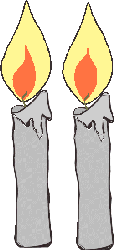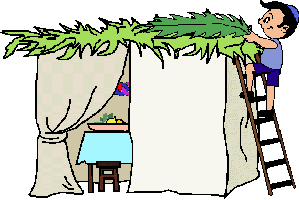|
Quick Guide to Holidays 5772 - 2011
Rosh HaShannah, Yom Kippur, Succot, Simchat Torah and in between
By Nachum Mohl
Tishre is the name of the Jewish month in which Rosh Hashanah, Yom Kippur, and Succot fall. Although Rosh Hashanah is the beginning of the Jewish year, and the first day of the Jewish month of Tishre, and is the first day of the year, Tishre is the seventh month in the Jewish year. The first month of the year is Nissan, the month in which Passover comes.
Tishre has more holidays than any other month, as we shall list:
S'lichot services begin for Askenazim on Saturday night, September 24th. It is traditional to begin the first service right after midnight. If it is not possible, S'lichot may be started on Sunday, September 25th. By the way, according to our Jewish tradition, it happens to come out that this year the date that G-d began creating the world falls on the Shabbat.
Rosh Hashanah is the holiday that celebrates the Jewish New Year. It falls on the first and second days of the month of Tishre. The two-day holiday is the only holiday that is celebrated both in Israel and in the Diaspora for two days. All other major holidays are celebrated in Israel for only one day and in the Diaspora for two days. Rosh Hashanah is the Day of Judgment for the entire world. All pass before Him and His heavenly court to be judged for their actions and deeds of the previous year and to receive a decree for the coming year.
This year, 2011, Rosh Hashanah comes on Thursday, September 29, and Friday, September 30. Remember the Jewish festivals begin when the sun sets.
Since the first two days of Rosh Hashanah come immediately before the Shabbat, and since it is forbidden to cook on the Yom Tov for the Shabbat, it is necessary to make an "eruv tavshelin" which is a process by which we begin to prepare for the Shabbat before the Yom Tov, and by virtue of this beginning, we are permitted to continue cooking even on Friday, the second day of Rosh Hashanah. To make an "eruv tavshilin", take a boiled egg (or other cooked food such as a piece of meat or fish) together with a loaf of bread that is to be eaten on the Shabbat and make the blessing, "...who has sanctified us by His commandments and commanded us concerning the precept of Eruv." After this blessing recite the following, "By virtue of this Eruv it is permitted to us to bake, cook, warm the food, light the candles and do all work that is necessary on the holiday for the Shabbat." This must be done before the festival and not on it. The blessing and other details can be found in many prayer books.
Many people go for the 'tashlich' ceremony on the afternoon of the first day. Tashlich is a prayer which is found in the holiday prayer book. It is said near a body of water preferable natural where there are fish. If it is difficult to walk such a great distance, it can be done in the days between Rosh Hashanah and Yom Kippur.
The third day of Tishre is a fast day. It commemorates the assassination of Gedaliah ben Achikom in the year 3339 after creation (421 BCE). He was the leader of the Jews that remained in the Land of Israel after the destruction of the First Temple. He was extremely pious and did not want to believe a report that told that a close friend would assassinate him. His death brought new calamities to the remaining Jews in Israel and culminated with the eventual total expulsion of the Jewish presence in the Land of Israel.
Since this year, 2011, the third day of Tishre falls on the Shabbat, the fast is pushed off until Sunday, the 1st of October
There are ten days from Rosh Hashanah to Yom Kippur; these are known as the Ten Days of Repentance. During this period it is an auspicious time to repent for sins committed. It is a special time for soul-searching and repentance.

This year Yom Kippur falls on the Shabbat. In our prayers, we mention that it is Shabbat, but of course we do not eat nor drink.
On the day before Yom Kippur the Kapport service is performed. Fowl is taken and swung around the head of each individual and then the bird is slaughtered. The custom today is to donate the fowl to a charity. Many people use money instead of fowl and then give the money to charity. Since it comes out on Friday, many people will do the Kapport ceremony earlier.
The fast begins on the ninth of Tishre (Friday evening, Oct. 9th) in the evening just before the sun sets. On the ninth of Tishre we eat easy digestible foods, and drink much liquid so that on the fast day we may pray with out interference from our stomachs. The fast begins just before the sunset and extends to the night after Yom Kippur when three stars become visible. On this day G-d forgives sins that are committed providing we are sincere and truly repentant. Sins committed against our fellow man are not forgiven on Yom Kippur unless we have rectified the wrong, such as asking forgiveness from the offended party or restituting money taken wrongly.
The night of Yom Kippur includes the famous 'Kol Nidre' prayer which allows all congregants to pray with those who have sinned, since it is impossible for us as a nation to achieve group forgiveness without inclusion of apparent sinners. The end of Yom Kippur features the special 'Neilah' prayer which is the prayer at the time of the closing of the heavenly gates.
The custom is to be happy and have a festive meal after Yom Kippur and then begin to do some work on the Succah.

The fifteenth of Tishre begins the Succot holiday. This year, 2011 it begins on Wednesday night, October 12th. In Israel the holiday is observed for only one day, on Thursday, but in the Diaspora it is observed for two day, Thursday and Friday. Since we have a three day bridge, Thursday, Friday and Shabbat, the "eruv tavshilin" must be used to permit cooking on the Yom Tov for the Shabbat.
The Succah is the booths which we build outside of our houses and cover with leaves, branches or small wooden slats. The Succah is to remind us of the temporary shelters in which our ancestors lived during the forty years that they wandered in the desert after leaving Egypt. It reminds us of the special protection that G-d affords to the Jews even during our times. During the festival of Succot, the four species, the etrog (citron), the lulav (top leave from a palm tree), hadas (myrtle) branches, and willow branches, are taken and blessed. Since the first day of Succah falls on the Shabbat, the four species are not handled on the Shabbat; we begin to take them only on the second day of the festival.
The seventh day of Succot is known as Hoshanah Rabbah. On this day, the world is judged for water and extra prayers are added to the prayer service. A special bunch of five willows (which are dependent of much water) are taken and smacked into the ground. Many have the custom to stay up the entire night of Hoshanah Rabbah studying. Work is permited on this day.
The eighth day of Succot is called Shemini Atzeret. In Israel it is observed for only one day, but in the Diaspora it is observed for two days, and the second day is given the distinctive name of Simchat Torah. In Israel, Shemini Atzeret is Simchat Torah. On Simchat Torah we conclude the yearly reading of the Torah and celebrate the conclusion and beginning of a new cycle of Torah readings with rejoicing with dancing and singing. This year, since Succot falls on Thursday and in the Diaspora a second day of Yom Tov is celebrated on Friday, an "eruv tavshilin" must be made to permit cooking on the Friday for the Shabbat.
Outside of Israel the holidays of Shemini Atzeret and Simchat Torah fall on Thursday and Friday. We again have a three day bridge and again the "eruv tavshilin" must be used.
~~~~~~~
from the September 2011 High Holyday Edition of the Jewish Magazine
|
